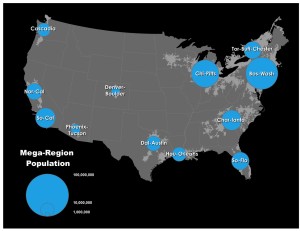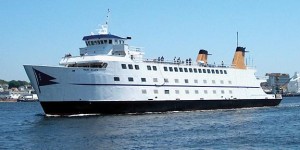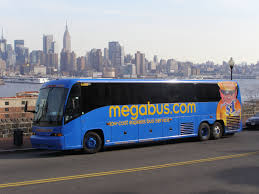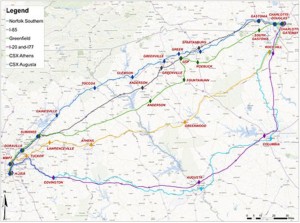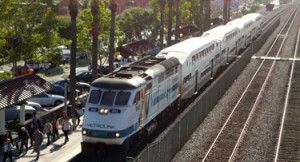In March, The Atlantic‘s City Lab, took a look into the power house economies of the so-called “megalopolises” of the United States. Author Richard Florida found that there were a dozen of the world’s 40 “mega-regions” here in America.
From the contiguous stretch of urban sprawl in New England, Florida named the Bos-Wash region, to the Pacific Northwest he called “Cascadia,” these dozen areas are the economic and population hubs of the country. According to Florida, “these dozen regions have a combined population of more than 230 million people, including 215 million from the United States, or 70 percent of the U.S. population.”
Many of these areas have various forms of public transportation, some well known and extremely popular, while others are continuing to face the needs and challenges associated with creating a successful network of transportation.
Beginning today, and over the weekend, we’ll take a look at how each of these regions are connected.
Bos-Wash: By far the largest population and economic output region on Florida’s list, Bos-Wash “stretches from Boston through New York, Philadelphia and Baltimore to Washington, D.C.” and is home to 56.5 million people. This densely populated part of the country has long had public transportation systems and in all shapes and sizes.
Bus lines such as Peter Pan Bus Lines run as far north as Connecticut and as far south as Washington D.C., according to travel-website Lonely Planet. Amtrak provides train services to the region with lines such as the “Downeaster,” which travels between Boston and Maine, or the “Vermonter,” which runs from Washington D.C., through New York City, to northern Vermont.
Other options for the region include ferries, such as the Long Island Ferry that connects Connecticut to New York’s Long Island, dropping riders in a terminal “eight miles from the Long Island Rail Road station with connections to New York City.”
Chi-Pitts: The Chicago to Pittsburgh region is second on Florida’s list of population and economic output in the U.S., and includes metropolitan areas such as Minneapolis, Detroit and Cleveland as well. Travel options connecting these regions include passenger trains via Amtrak, including to places such as Chicago, Minneapolis and Indianapolis, or the Megabus, which has fares as low as $1.
Megabus came to Chicago in 2006 and used a low-cost system of online reservations, lower fares the early reservations are booked, and sidewalk pickups instead of terminals, according to the Seattle Post-Intelligencer. It’s a particularly important source of transportation to and from college campuses.
Char-lanta: This region is home to 22 million people, according to Florida, and its economic impact is large enough to be in the top 15 economics in the world if it were isolated. The Char-lanta region includes metropolises such as Atlanta, Georgia, Raleigh, N.C. and Birmingham, Ala.
Similar to the Chi-Pitts, Megabus expanded to cover much of this region in 2011, and Amtrak has service from Charlotte, N.C., through Atlanta and Birmingham, Ala. The Georgia Department of Transportation has also been working on a high-speed passenger rail investment plan seeking to connecting Atlanta to Charlotte, N.C.
So-Cal: The first west coast region on Florida’s list includes Los Angeles, San Diego and Tijuana, Mexico. Travelers between San Diego, Orange County and Los Angeles have Amtrak’s Pacific Surfliner Train but also have access to the Metrolink, which offers other routes throughout Los Angeles, Orange County and northern San Diego County. City-to-city travelers can also use Greyhound bus lines or shuttle services.
Check back tomorrow as we continue our look into how the “Megalopolises” are connected.

